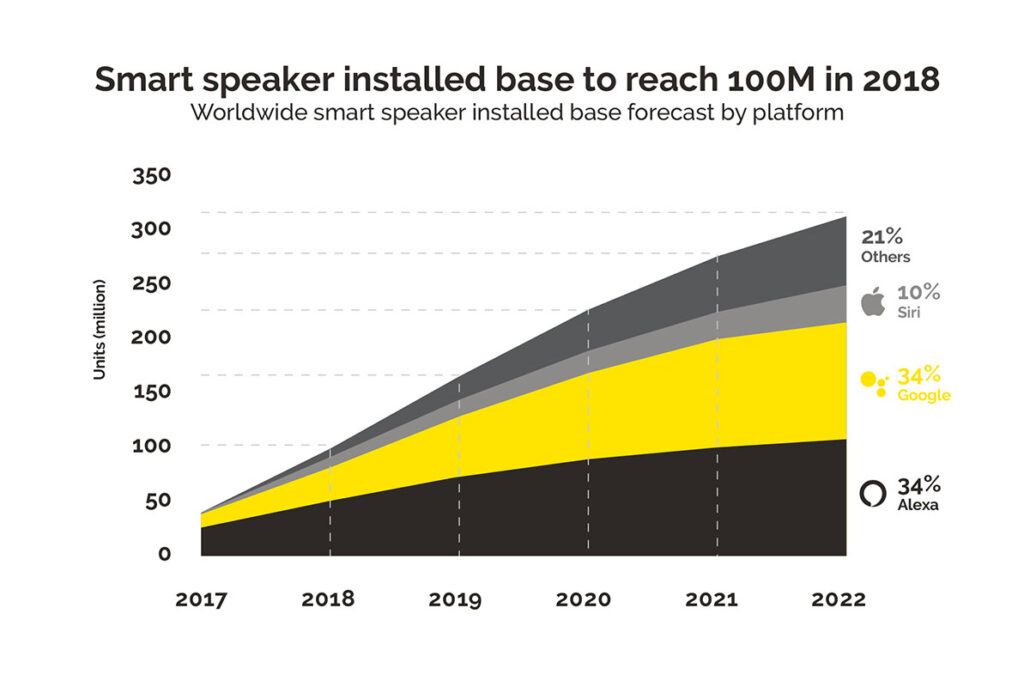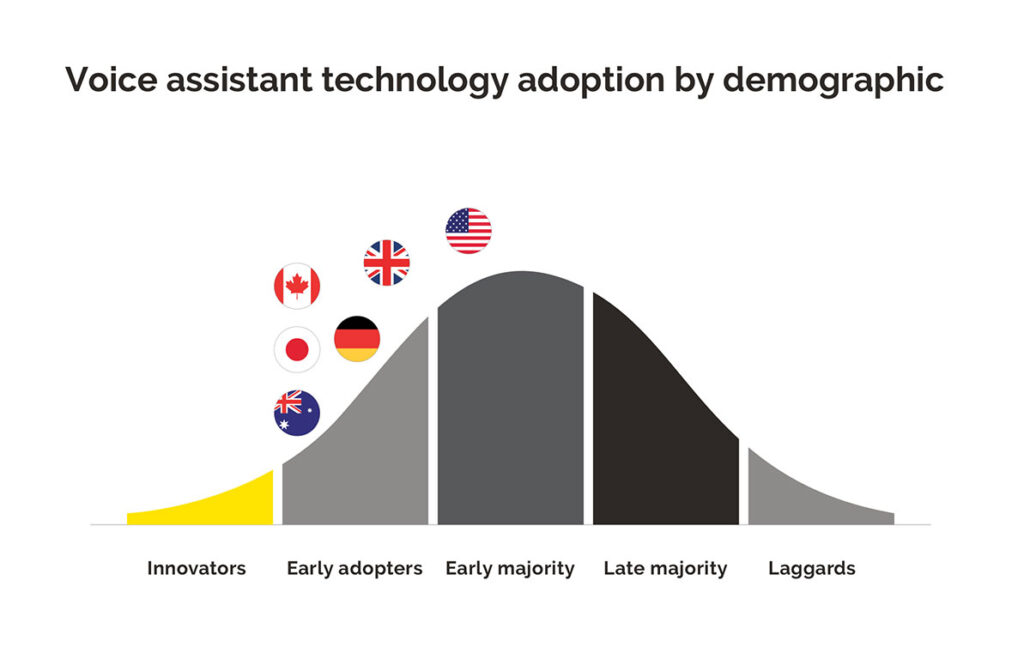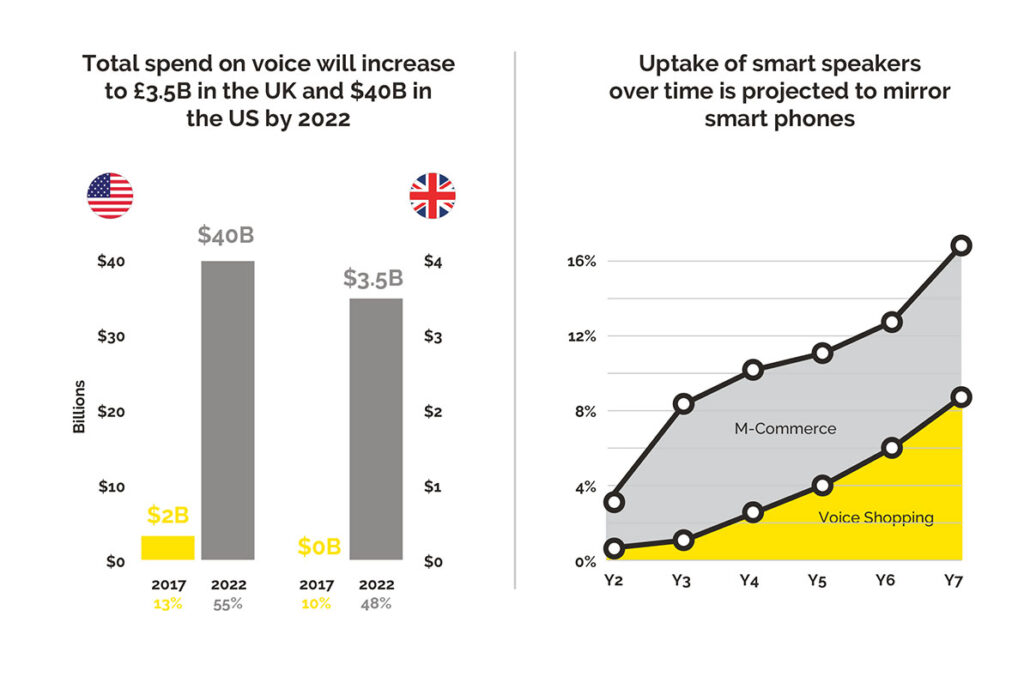Future of voice search
According to Canalys, 2018 will be recorded as a milestone year for smart speakers as the number of installed base units hits 100m. But that is just the beginning. By the of 2019, is predicted to double, before trebling by 2022 to 300m.
As the numbers grow, Alexa’s dominance is set to decline from accounting for around a half of all smart speakers shipped in 2019, to just over a third of an enlarged market in 2022. It will still share the top spot with Google, each enjoying a 34% market share, with Apple’s 10% overshadowed by the 21% share shared by the ‘others’.
This ‘others’ category will include the rising Chinese stars of Alibaba and JD.com, which between them already account for 8% of smart speakers shipped in 2018. However, their growth is largely restricted to their domestic market and will not greatly impact Google, Alexa and Siri outside China.
Maturity of markets
The doubling of sales between 2018 to 2019 will see the US move towards ‘Late majority’ status next year, while the UK and Germany will be coming out of the ‘Early adopter’ phase, as this graph from late 2018 shows.
Will voice search be monetised?
As ‘Early adopters’ become the ‘Early majority’ in the UK and Germany, and America heads towards greater maturity, the question of paid-for voice search advertising is bound to arise.
The public got a glimpse of how paid-for slots might pan out back in 2017 when The Verge reported on a strange end to Google’s ‘My Day’ feature. Owners asking, ‘How does my day look?’ got the usual rundown of commute time and the weather, finishing off with the unprompted news that Disney’s Beauty and the Beast was opening in cinemas. Google claims this was not an advert, but a service offered to users where it calls out useful information about local events, so users can plan their day ahead.
However, even if it is accepted that this was not an advert, but a useful announcement on a new movie opening, it is clear that this could be a prototype. Google, or another voice search provider, could easily attach the audio equivalent of a post-roll spot (typically an advert after a television programme) in which an apt, paid-for announcement is made at the end of an organic result.
Another monetisation method, according to Econsultancy, could be a voice assistant reading out the top organic answer and then asking a user if they would like to hear more from a sponsoring brand on the topic. A query on what do on a weekend trip might receive an organic answer about the city’s top sights with the offer to hear from a travel company that arranges tours there.
Will screens bring links to voice search?
It should not be forgotten that smart speakers are now being shipped with screens, such as the Google Home Hub, Amazon Echo Show and the Facebook Portal. These not only allow users to hear what Alexa or Google Assistant is talking about, but also show relevant content.
Where there is a screen, there is obviously always an option for PPC results to be placed above a list of organic links, just as they would be on a desktop. It would then be down to a user to select a link with a press of a button or ask an assistant to open up a paid-for link.
Will voice commerce be a $40bn market by 2022?
This is, literally, the billion-dollar question. At the beginning of 2018, OC&C Strategy Consultants issued a very upbeat report stating that with 10% of the UK owning a smart speaker, voice commerce was only worth £0.2bn in 2017. However, as ownership spreads to nearly one in two Brits in 2022, voice commerce will expand quickly and is estimated to be worth £3.5bn a year.
The same consultants also predict the US and UK combined market for voice commerce would shoot up in value from $2bn in 2018 to and estimated $40bn by 2022.
The researchers further claim that 36% of US smart speaker owners currently regularly shop via their smart speaker and the same applies to 16% of UK owners.
In their research, the firm claimed the current breakdown of the market shows grocery is the biggest category accounting for 20% of voice orders, with entertainment (19%) electronics (17%) and clothing (8%) the next largest markets.
However, The Information caused a stir in the summer of 2018. It that sources with access to Amazon’s figures revealed that just 2% of Alexa users have ordered a product via voice. Furthermore, the article claimed, 90% of these shoppers who tried voice commerce did not order again.
Amazon has denied the figures, claiming that millions of shoppers are regularly placing orders via voice. Indeed, one interesting aspect of The Information article is it pointed out the same sources reveal one in five users regularly use voice commerce commands. These can include checking on the status of orders and what deals are available to them.
So, even among those with the most pessimistic predictions for voice commerce, it’s acknowledged that there is an appetite to use voice for commerce-related enquiries. This shows, at the very least, that this is a market with pent-up demand that will likely fuel further growth from today’s ‘Early adoption’ phase.




